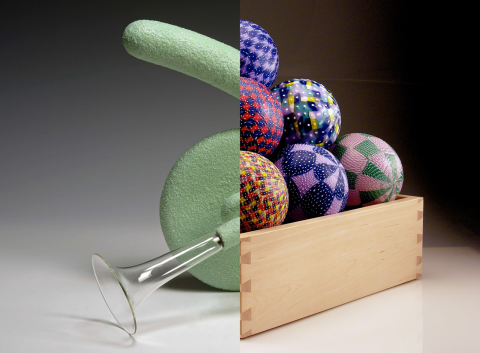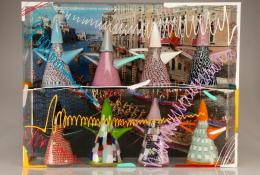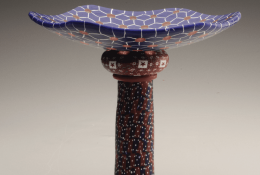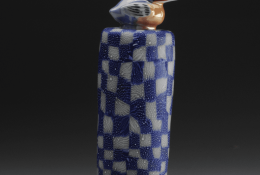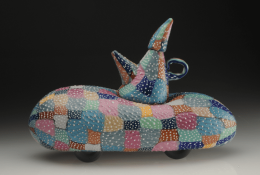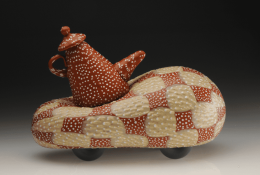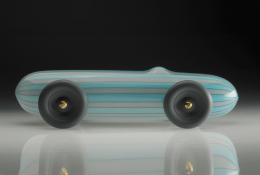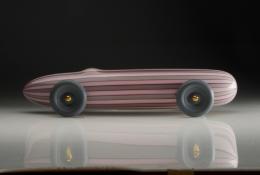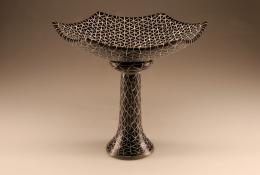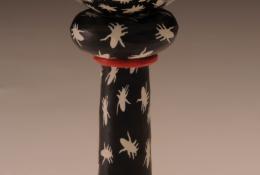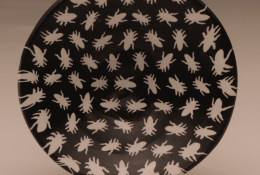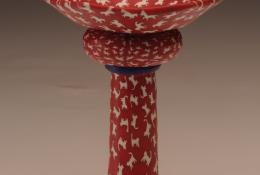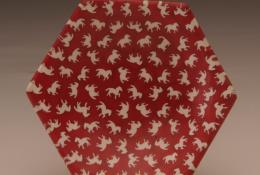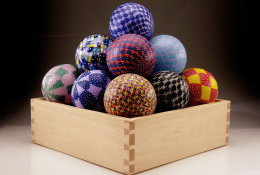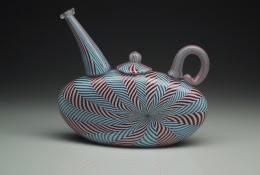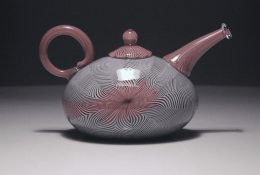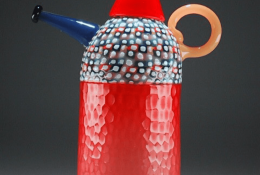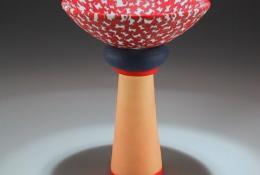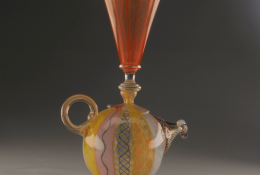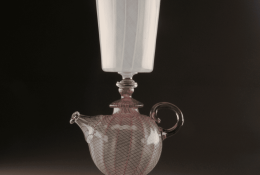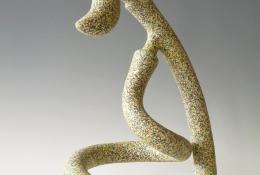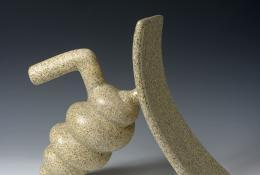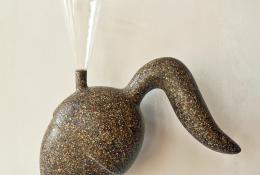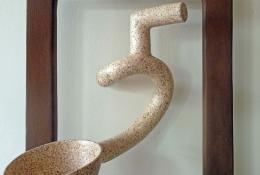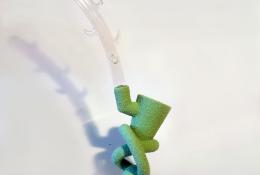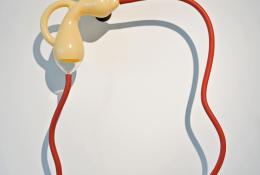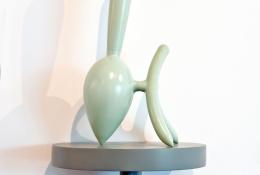The Richards
Richard Marquis
Coming from the San Francisco Bay Funk Art Movement and trained in Berkeley, USA during the 1960’s, Richard Marquis travelled to Italy thanks a Fulbright Grant and learned the techniques of filigrana and murrina at Venini in Murano in 1968, then returned to the USA where he built his own furnace, becoming one of the leading figures in the development of the American Studio Glass Movement in USA.
Marquis is a compulsive collector of found objects, a dog lover, highly witty and a great matcher of different materials and techniques. His work is mostly focused on colour and form, humour, experimentation, with an intellectual background and knowledge of the history of Art and hand blown glass technique.
For this show, Marquis is presenting different works made between 1990 and 2017, characteristic of diverse phases in his career. Teapots, inspired by the American Pot Tradition but made with the use of murrine, zanfirico and granulare techniques, and two early examples from 1990; the famous Marquiscarpas, using a complex murrine technique, and named in honour of the Venetian Architect Carlo Scarpa, famous designer for Venini during the 1940’s. In addition he is showing the colourful Cartoon Cars in granulare technique and a brand new work dedicated to Venice: Venezia Puzzle Fan with Teapots, a wall piece with glass and found objects, recalling the Venetian cityscape.
Richard Meitner
Meitner’s practice has always traversed the thresholds between art and applied arts, sculpture and installation, science and poetry, usually defying any classification. His works represent eccentric-fantastic objects, often in relationship to elements from the natural world, such as animal and plants. Inspired by his decades of experience working with blown glass, Meitner has created a series of works for this show that are immediately recognisable as related to the typical forms and movements of hot glass, but extend the shape and surface texture possibilities of this medium very greatly through the use of different media, for example, fibreglass. In these pieces, often he makes use of terrazzo technique, an architectural-design element that is an integral part of the history of the city of Venice.
The artist characterizes his artistic practice as based on magic, surprise and feeling as opposed to being generated from theory or single concepts that can be captured in a few words. However, Meitner is by no means an enemy of words, often giving titles to his works that suggest an idea, an event, a historical personnage or a shape. Here he will be showing: Not a peep, a green work in glass and fiberglass, the title referencing the famous painting Ceci n’est pas une pipe by Magritte; or Wurst that could happen, a sculpture playing on the idea of a trumpet and the title on the resemblance between the words “wurst” and “worst”.
RICHARD MARQUIS | SHORT BIOGRAPHY
“[...] Richard Marquis has had an extraordinary influence on the development of contemporary studio glass in America and around the world. Studying at the University of California at Berkeley during the 1960’s, he explored ceramics and was introduced to glassblowing. Unsatisfied by the limited techniques practiced in America at that time, Marquis went to the island of Murano, near Venice, to observe and work with the masters of glassblowing tradition acknowledged as the best in the world. Freely sharing his knowledge of the techniques he learned in Venice, Marquis has demonstrated and taught throughout the United States, Europe, Japan, Australia and New Zealand. The effect of Venetian glassblowing techniques on American studio glass enabled glass artists to expand their technical vocabularies and, combined with new and experimental approaches, led to the redefinition of glass as an artistic medium. As an artist, Marquis is admired for his sophisticated understanding of colour and form as much as for his humour and willingness to experiment. As a glassblower, he has influenced an entire generation of artists working with glass who aspire to his technical mastery and the originality of his voice[...]” Tina Oldnow – Independent Curator and former Senior Curator of Modern and Contemporary Glass at Corning Museum, N.Y.
RICHARD MEITNER | SHORT BIOGRAPHY
Richard Meitner is an artist with decades of experience and practice in art and art education. Richard Meitner has lectured and conducted workshops in the U.S.A., Great Britain, the Netherlands, Germany, France, Spain, Malta, Portugal, Sweden, Denmark, the Czech Republic, Italy and Japan. He has been invited artist-in-residence in many countries and has worked as a designer for the glass industry in Italy, Germany, Austria, Switzerland, the Netherlands, and Belgium. Additionally, Meitner has served on the Dutch National Commission for Endowments for the Arts, and the Dutch National Advisory Board for the Arts. Together with Mieke Groot, he was responsible from 1981 to 2000 for the glass department of the Gerrit Rietveld Academy in Amsterdam. In 2006, he was appointed to the faculty for Science and Technology of the Universidade Nova de Lisboa (New University of Lisbon), Portugal. His major exhibitions include a retrospective at the Musee des Arts Decoratifs of the Louvre in Paris, and solo shows at the National Museum for the History of Science and Medicine in Leiden, Netherlands, the National Glass Museum in Sunderland, England, the Stedelijk Museum in Amsterdam, and the Corning Museum of Glass in the U.S.A.. Meitner’s work is included in the permanent collections of more than 60 museums in 16 countries.
In 2016 Meitner earned a PhD in sculpture from the Faculty of Fine Arts of the University of Lisbon, Portugal. Meitner’s doctoral thesis makes the case that in education and public policy for art, the way we define, make policy for and teach art is in many respects incorrect and ineffective. He formulates his arguments citing science and many other sources that strongly suggest that we need urgently to discuss, rethink and come to much more accurate and useful understandings of what making and appreciating art are really about.
